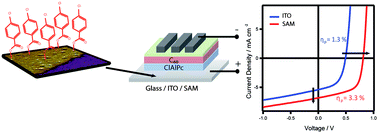Increased efficiency in small molecule organic photovoltaic cells through electrode modification with self-assembled monolayers
Abstract
We report that through the incorporation of polar self-assembled monolayers (SAMs) at the indium tin oxide (ITO)/donor interface in chloroaluminium phthalocyanine (ClAlPc)/C60 discrete heterojunction organic photovoltaic (OPV) cells, the power conversion efficiency can be dramatically increased. This enhanced performance is due to better alignment between the hole-extracting electrode Fermi level and the highest occupied molecular orbital (HOMO) of the ClAlPc donor, as well as an improved surface compatibility which provides a more optimised


 Please wait while we load your content...
Please wait while we load your content...